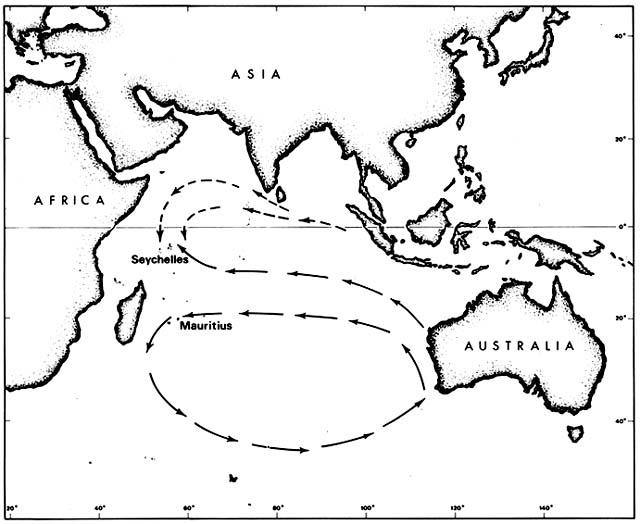Introduced Indo-Pacific Species, Mauritius
(Sauer 1961, 1967b )
Several Indo-Pacific shrubs and trees that are now naturalized along the Mauritius coast would probably be mistaken for natives without the historical record of their introduction.
Mauritius was uninhabited and visited only occasionally by Portuguese and Dutch ships before being temporarily colonized by the Dutch in the seventeenth century. Permanent settlement began with arrival of the French in 1715. Soon after, Mauritius began playing a leading role in the great exchanges of tropical plants between botanical gardens of European colonial powers. Its great botanical gardens at Pamplemousses and Reduit were world famous. Beach species were a very minor part of their collections.
In the mid-eighteenth century, Mauritius acquired Casuarina equisetifolia and Calophyllum inophyllum from Madagascar and Terminalia catappa from Bengal. In the early nineteenth century, Morinda citrifolia was imported from India and Desmodium umbellatum from an unspecified source. In the late nineteenth century, Pongamia pinnata was imported from the Seychelles. All of these have become naturalized as volunteers in natural coastal habitats on Mauritius, probably spreading around the island by floating seeds. Terminalia is also dispersed by the native fruit bats or flying foxes.
The story of Cocos nucifera is less clear. Coconut palms were reported on the Mauritius coast in 1598 by the first Dutch expedition. Whether they arrived on their own or were introduced by the Portuguese is unknown. In any case, coconuts are rarely found today along the Mauritius coast except where planted.
It is not immediately obvious why any of these species should have had to await human transport in order to reach Mauritius. All except Casuarina are known to be capable of long-range dispersal. Casuarina seeds survive immersion in salt water indefinitely but are not buoyant. They are believed to cross ocean barriers by rafting, particularly by floating pumice on which they have been seen germinating. Moreover, all these species were native on various other Indian Ocean islands, including the Seychelles, which lie in the same longitude as Mauritius (fig. 2).
The Seychelles were uninhabited when discovered by a British ship in 1609; wild coconut palms lined the beaches then. The archipelago remained uninhabited until colonized by French from Mauritius in the mid-eighteenth century, initially to exploit the wild coconuts. The first colonists also encountered coastal Casuarina, Calophyllum , and Terminalia groves. They were amazed at the size of the Terminalia trees, which they had known in Mauritius as saplings. Morinda and Pongamia were probably also naturally established

Figure 2. Prevailing Indian Ocean Currents Upstream from Seychelles and Mauritius. Although the currents
are not constant, drifting seeds of tropical beach plants are more likely to reach the Seychelles than Mauritius.
Some such species that arrived prehistorically in the Seychelles have since been artificially introduced to Mauritius.
in the Seychelles, although the first clear records are from the nineteenth century.
The rich native beach flora of the Seychelles, as compared to Mauritius, may result from the pattern of ocean currents. The Seychelles lie in the Equatorial Current downstream from Java, the rest of the East Indies, and many Pacific islands. Mauritius is far enough south to lie within the great counterclockwise circulation around the southern Indian Ocean and is thus downstream from the southern and western coasts of Australia. Such currents are variable, of course, but evidently not enough to erase different effects on dispersal.